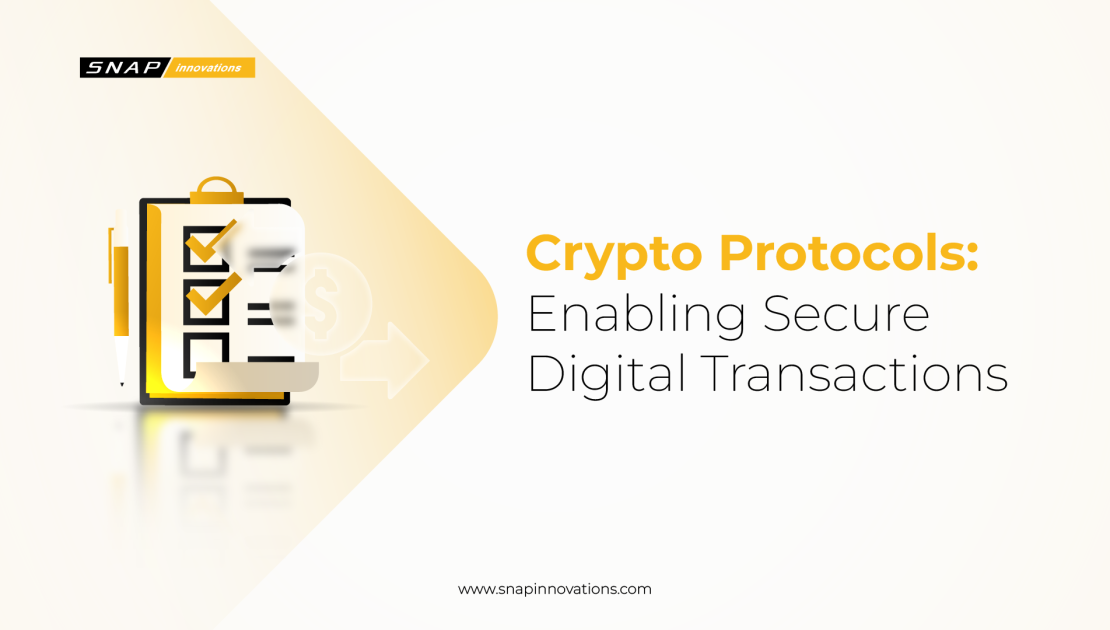In the ever-evolving landscape of digital finance, crypto protocols are the silent architects, the unsung heroes. They serve as the building blocks that underpin the entire ecosystem, enabling secure and transparent transactions in the world of cryptocurrencies.
This article is your gateway to understanding crypto protocols, what they are, how they work, and why they are pivotal in shaping the future of digital finance.
What is a Crypto Protocol?
At its core, a crypto protocol is a set of predefined rules and procedures that govern the interactions within a blockchain network. Think of them as the rulebook of the digital financial world, providing a standardized way for participants to conduct transactions, achieve consensus, and ensure the integrity of the network. These protocols are designed to operate on decentralized networks, eliminating the need for intermediaries like banks or payment processors.
One of the most well-known examples of a crypto protocol is the Bitcoin protocol. It dictates how new bitcoins are created, how transactions are validated, and how the blockchain ledger is maintained. Through cryptographic techniques, the protocol ensures the security and immutability of the blockchain, allowing individuals to trustlessly transact and store value in the form of Bitcoin.
Moreover, crypto protocols facilitate smart contracts, enabling programmable and self-executing agreements that further expand the capabilities and applications of blockchain technology. As the cryptocurrency landscape continues to evolve, crypto protocols remain at the core of innovation, providing the infrastructure for a wide range of decentralized applications and financial services.
How Crypto Protocols Work
Understanding how crypto protocols work requires a glimpse into the inner workings of blockchain technology.
1. Data Structure and Consistency
Crypto protocols define the data structure of a blockchain, specifying how transactions are organized into blocks and linked together. This data structure typically involves a distributed ledger format where each block contains a set of transactions and a reference to the previous block, forming a chain.
To maintain data consistency across the network, cryptographic hashing techniques like SHA-256 are used to create a unique fingerprint (hash) for each block. This ensures that any tampering with data within a block would change its hash, immediately alerting the network to the issue. Additionally, Merkle trees are employed to efficiently verify the contents of a block, making the blockchain both secure and scalable.
2. Consensus Mechanisms
One of the pivotal aspects of crypto protocols is the consensus mechanism, which determines how nodes in the network agree on the validity of transactions and the order in which they are added to the blockchain. Popular mechanisms like Proof of Work (PoW) and Proof of Stake (PoS) require nodes to perform specific tasks or stake cryptocurrency as collateral to participate in the consensus process.
In PoW, miners compete to solve complex mathematical puzzles, with the first to solve it adding a new block to the chain. PoS, on the other hand, selects validators based on the amount of cryptocurrency they hold and are willing to “stake” as collateral. These mechanisms play a crucial role in preventing double-spending and maintaining the security of the blockchain, and they are continuously evolving to address scalability and energy efficiency concerns.
Also Read: Data Mining: How it Works?
3. Transaction Validation
Crypto protocols establish rules for transaction validation. Transactions must meet predefined criteria to be considered valid, such as digital signatures proving ownership of assets and adherence to the protocol’s transaction format. Once a transaction is broadcast to the network, nodes validate it by checking the sender’s balance, verifying digital signatures, and confirming that the transaction complies with protocol rules.
Once validated, transactions are included in a candidate block awaiting confirmation through the consensus mechanism. This rigorous process ensures the security and integrity of transactions within the blockchain.
4. Security through Cryptography
Security is paramount in the world of cryptocurrencies, and crypto protocols employ advanced cryptographic techniques to protect user data and the integrity of transactions. These protocols use cryptographic algorithms for functions like digital signatures, encryption, and hashing to ensure the privacy and immutability of data. For example, digital signatures confirm the authenticity of transactions by proving that they were authorized by the rightful owner of the assets.
Encryption ensures that sensitive data remains confidential, even when stored on a public ledger. Hashing is employed to create fixed-length, unique fingerprints for data, ensuring its integrity and preventing unauthorized modifications. The use of cryptography is fundamental in safeguarding the blockchain’s security and privacy features.
5. Network Governance
Governance mechanisms are integrated into crypto protocols to address decision-making processes within blockchain communities. These mechanisms include on-chain voting, proposals for protocol upgrades, and discussions among network participants. They help maintain the protocol’s relevance and adaptability to evolving needs. Network governance is essential for achieving consensus on protocol changes, preventing centralization, and ensuring the network’s long-term sustainability.
Different crypto projects employ varying governance models, such as decentralized autonomous organizations (DAOs) or delegated consensus systems, each with its unique approach to decision-making. Effective governance ensures that the protocol remains robust, secure, and responsive to the community’s desires and challenges.
6. Smart Contracts
Many crypto protocols support smart contracts, self-executing agreements with predefined conditions and rules. These contracts enable decentralized applications (DApps) to automate various processes, from simple transactions to complex financial instruments. Smart contracts are executed on the blockchain, ensuring transparency and trust.
They expand the functionality of crypto protocols beyond simple value transfer, opening up opportunities for decentralized finance (DeFi), decentralized applications (DApps), and more. Ethereum, for example, introduced the concept of smart contracts, which has since catalyzed the development of a wide range of decentralized applications and financial services, revolutionizing the blockchain ecosystem.
7. Interoperability and Standards
Crypto protocols may incorporate interoperability features, allowing them to communicate and interact with other blockchains or external systems seamlessly. These interoperable protocols enable cross-chain communication, asset transfers, and data sharing, fostering a more connected and versatile blockchain ecosystem.
Additionally, adherence to specific industry standards is crucial for ensuring compatibility and facilitating cross-chain transactions. Interoperability initiatives and protocols, such as Polkadot and Cosmos, aim to create a unified blockchain ecosystem where different networks can collaborate and leverage each other’s capabilities. These efforts pave the way for innovative use cases and increased adoption of blockchain technology on a global scale.
Crypto protocols are the foundational elements of blockchain networks, providing the rules and mechanisms that enable trustless and secure digital transactions. Understanding how these protocols work is essential for anyone involved in the cryptocurrency space, as they underpin the entire ecosystem and influence factors such as scalability, security, and decentralization.
As blockchain technology continues to evolve, crypto protocols will play a central role in shaping the future of digital finance, decentralized applications, and global interactions. Their adaptability, security features, and consensus mechanisms will continue to be refined to meet the evolving needs of the blockchain community and the broader digital landscape.
The Role of Crypto Protocols in Digital Finance
 Crypto protocols are not just the foundation; they are the driving force behind digital finance. They enable the creation, management, and transfer of digital assets while ensuring the security and transparency of transactions. These protocols also play a pivotal role in challenging traditional financial systems and offering innovative solutions.
Crypto protocols are not just the foundation; they are the driving force behind digital finance. They enable the creation, management, and transfer of digital assets while ensuring the security and transparency of transactions. These protocols also play a pivotal role in challenging traditional financial systems and offering innovative solutions.
One of the most profound impacts of crypto protocols is their potential to democratize finance. Traditional financial systems are often centralized, excluding a significant portion of the global population from access to essential financial services. Crypto protocols, operating on open and permissionless networks, break down these barriers, allowing anyone with an internet connection to participate in the global economy.
Moreover, crypto protocols have ushered in the era of decentralized finance (DeFi). This flourishing ecosystem encompasses a wide range of financial services and applications built on blockchain technology. DeFi leverages crypto protocols to create decentralized lending platforms, decentralized exchanges, and yield farming opportunities, among others. These innovations challenge traditional financial intermediaries, granting users greater control over their financial assets and introducing a new era of financial inclusivity.
Types of Crypto Protocols
 Within the realm of crypto protocols, various types serve distinct purposes. Understanding these categories provides insight into the versatility of blockchain technology:
Within the realm of crypto protocols, various types serve distinct purposes. Understanding these categories provides insight into the versatility of blockchain technology:
1. Payment Protocols
Payment protocols are designed to facilitate the transfer of digital assets between users. Bitcoin’s protocol, for instance, is primarily a payment protocol. It defines how transactions are created, verified, and added to the blockchain.
Users can send bitcoins to each other by constructing and broadcasting transactions adhering to the payment protocol’s rules. Payment protocols have evolved to support faster transactions and lower fees, addressing some of the challenges faced by early cryptocurrencies.
2. Smart Contract Protocols
Smart contract protocols, like Ethereum’s, enable the execution of self-executing contracts with predefined rules and conditions. These protocols extend the functionality of blockchain networks by allowing developers to build decentralized applications (DApps) on top of them.
Ethereum’s protocol, for instance, enables developers to create and deploy smart contracts, powering a wide range of DApps, including decentralized finance (DeFi) platforms, non-fungible token (NFT) marketplaces, and more.
3. Privacy Protocols
Privacy-focused crypto protocols prioritize confidentiality in transactions and user data. Zcash, for example, employs a privacy protocol that allows users to make shielded transactions, where the sender, receiver, and transaction amount are hidden from public view.
Monero is another cryptocurrency known for its strong privacy features. These protocols use advanced cryptographic techniques to enhance privacy while still maintaining the integrity and security of the blockchain.
4. Consensus Protocols
Consensus protocols dictate how nodes in a blockchain network agree on the state of the ledger. Bitcoin’s Proof of Work (PoW) and Ethereum’s upcoming transition to Proof of Stake (PoS) are examples of consensus protocols.
PoW requires miners to solve complex puzzles to add new blocks to the blockchain, while PoS selects validators based on their holdings of cryptocurrency. These protocols ensure agreement among network participants and secure the network against malicious actors.
5. Cross-Chain Protocols
Cross-chain protocols aim to enable communication and asset transfers between different blockchain networks. They are vital for achieving interoperability in the blockchain space. Projects like Polkadot and Cosmos use cross-chain protocols to create a network of interconnected blockchains.
This allows assets to move seamlessly between chains and opens up possibilities for decentralized applications that span multiple blockchains.
6. Governance Protocols
Governance protocols define how decisions are made within a blockchain network’s ecosystem. These protocols often involve on-chain voting, proposals, and discussions among network participants.
For example, Decentralized Autonomous Organizations (DAOs) are governed by specific protocols that allow token holders to vote on proposals and determine the direction of the organization. Governance protocols play a crucial role in maintaining the network’s decentralization and adapting to changing circumstances.
7. Token Protocols
Token protocols standardize the creation and management of digital tokens on blockchain networks. Ethereum’s ERC-20 token standard, for instance, defines a set of rules that a token must adhere to in order to be considered an ERC-20 token. This standardization ensures compatibility and enables tokens to be easily integrated into various applications, such as exchanges, wallets, and DApps.
Token protocols have played a pivotal role in the proliferation of blockchain-based assets and tokenization of real-world assets, contributing to the growth of decentralized finance (DeFi) and the broader blockchain ecosystem.
Each type of crypto protocol serves a specific purpose and contributes to the functionality and versatility of blockchain networks. The diversity of these protocols enables blockchain technology to address a wide range of use cases, from peer-to-peer payments to complex decentralized applications, privacy-preserving transactions, and cross-chain interactions.
The Future of Crypto Protocols
 The future of crypto protocols holds immense promise and potential as blockchain technology continues to mature and evolve. These protocols will play a pivotal role in shaping the decentralized digital landscape, with ongoing developments focused on scalability, interoperability, and sustainability. Scalability solutions like Layer 2 solutions and sharding aim to address blockchain’s throughput limitations, enabling faster and more efficient transactions.
The future of crypto protocols holds immense promise and potential as blockchain technology continues to mature and evolve. These protocols will play a pivotal role in shaping the decentralized digital landscape, with ongoing developments focused on scalability, interoperability, and sustainability. Scalability solutions like Layer 2 solutions and sharding aim to address blockchain’s throughput limitations, enabling faster and more efficient transactions.
Moreover, advancements in cross-chain and interoperability protocols will foster a seamless flow of assets and data across different blockchain networks, creating a truly interconnected digital ecosystem. Additionally, privacy and security-focused protocols will continue to enhance user data protection and transaction confidentiality, promoting trust in blockchain applications. Governance protocols are also evolving to facilitate more decentralized decision-making, ensuring that blockchain networks remain adaptable and responsive to the needs of their communities.
Furthermore, token protocols will continue to underpin the creation and management of diverse digital assets, supporting the growth of decentralized finance, non-fungible tokens, and tokenized real-world assets. In summary, the future of crypto protocols is marked by innovation and expansion, with these foundational elements driving the adoption and utility of blockchain technology across various industries and use cases.
Also Read: Operating Margin: Strategies for Continual Improvement
Conclusion
In conclusion, crypto protocols are indeed the unsung heroes of the digital finance revolution, silently powering the world of blockchain and cryptocurrencies. As the world continues to embrace blockchain technology, these protocols will play an even more indispensable role, offering endless possibilities and reshaping the future of finance in ways we can only begin to imagine.
These protocols embody the principles of decentralization, security, and transparency, standing as a testament to the potential for a more inclusive and equitable financial landscape. They are the invisible hands that guide and govern the digital economy, ensuring that transactions are secure, data is protected, and trust is maintained.


